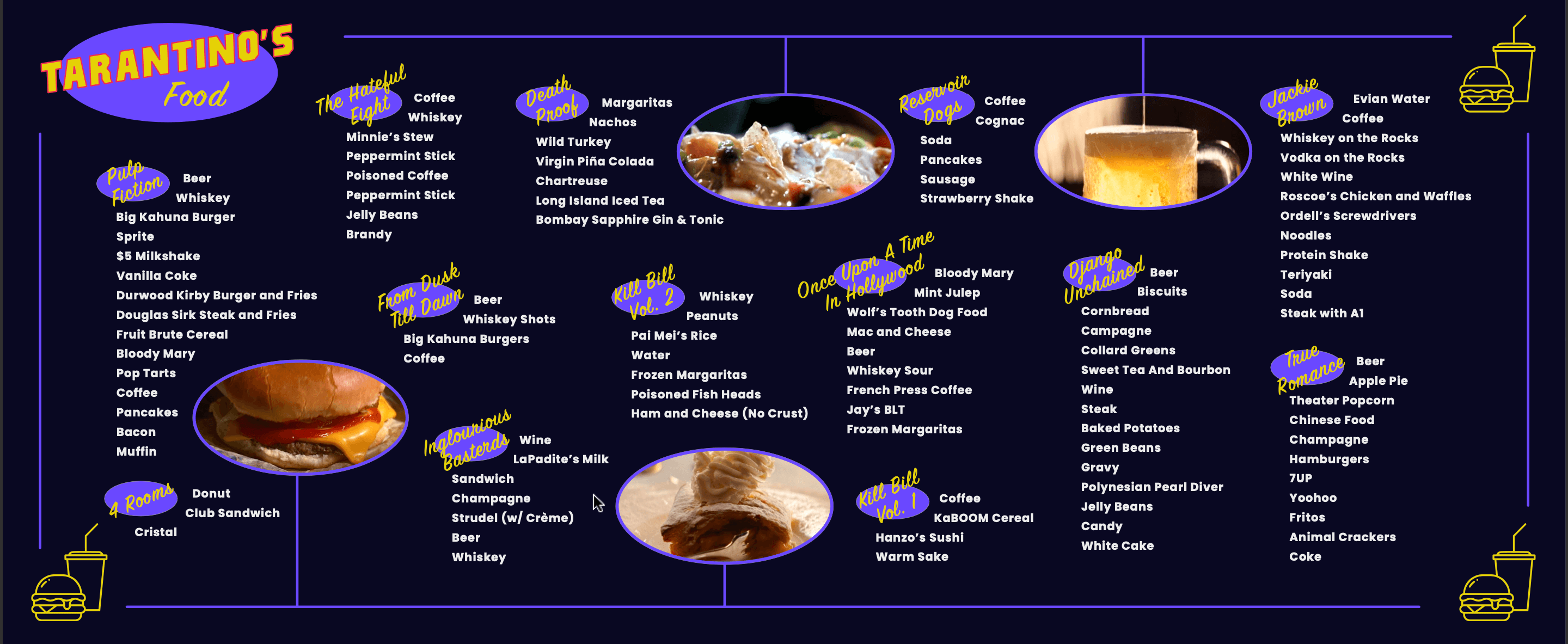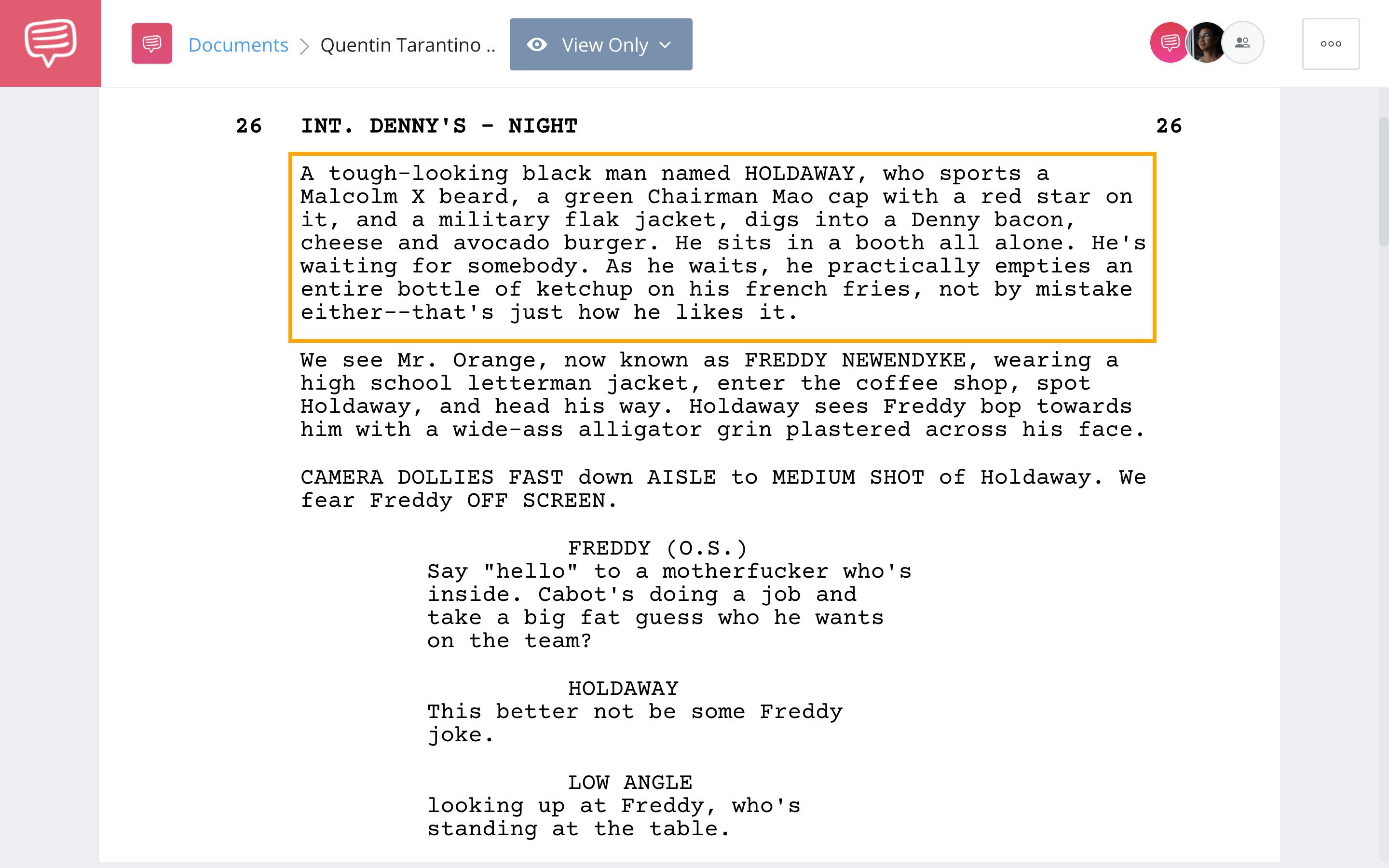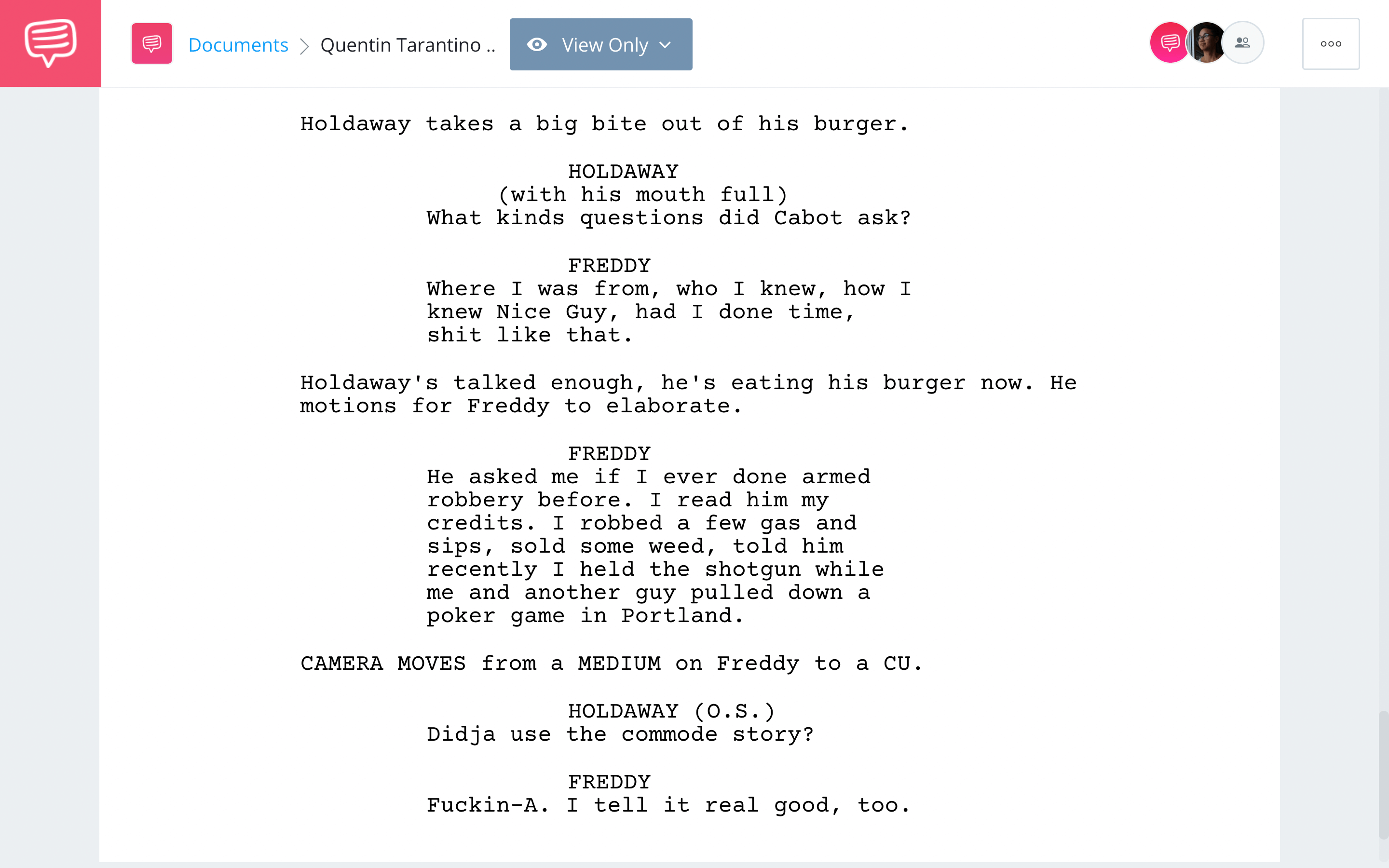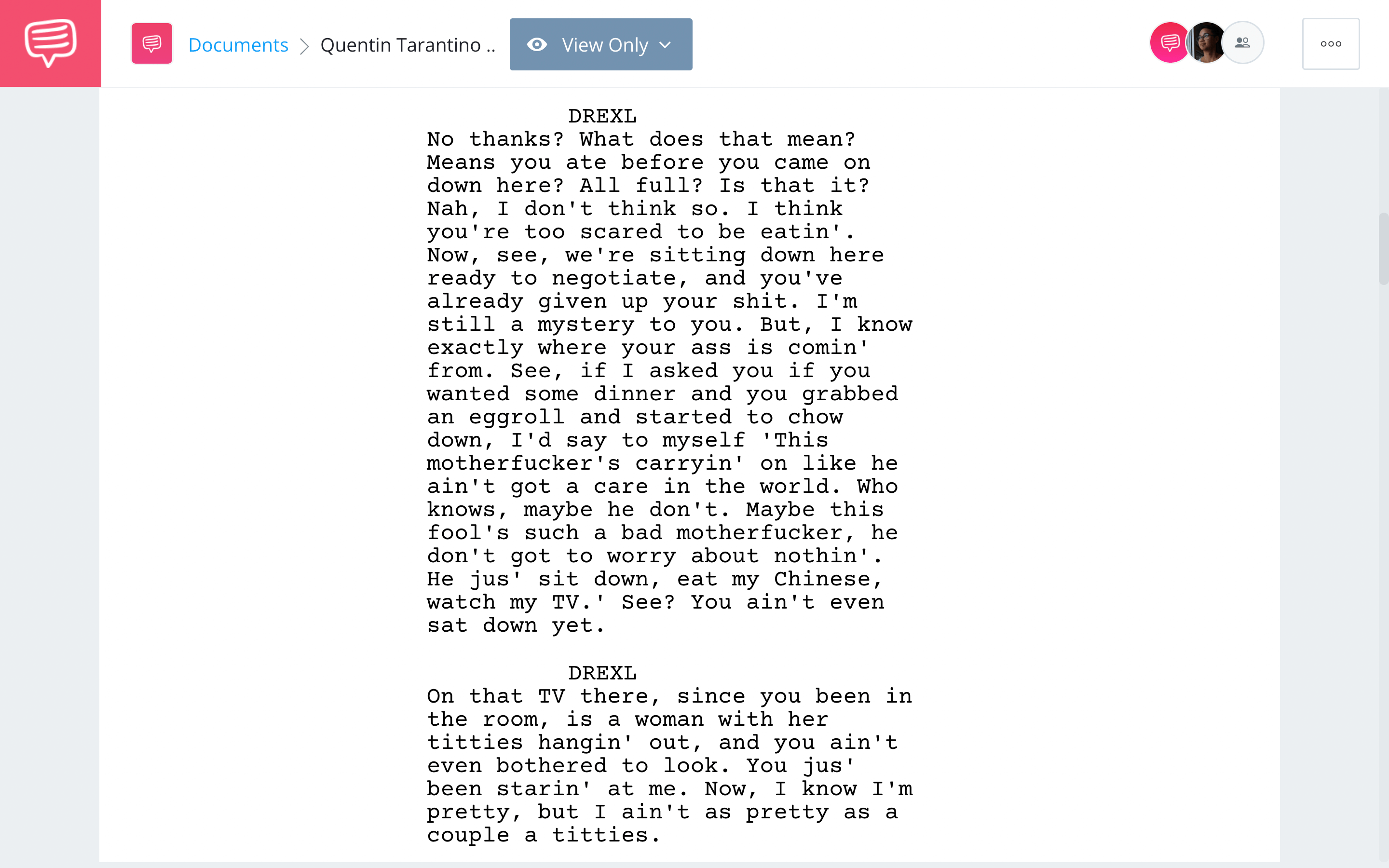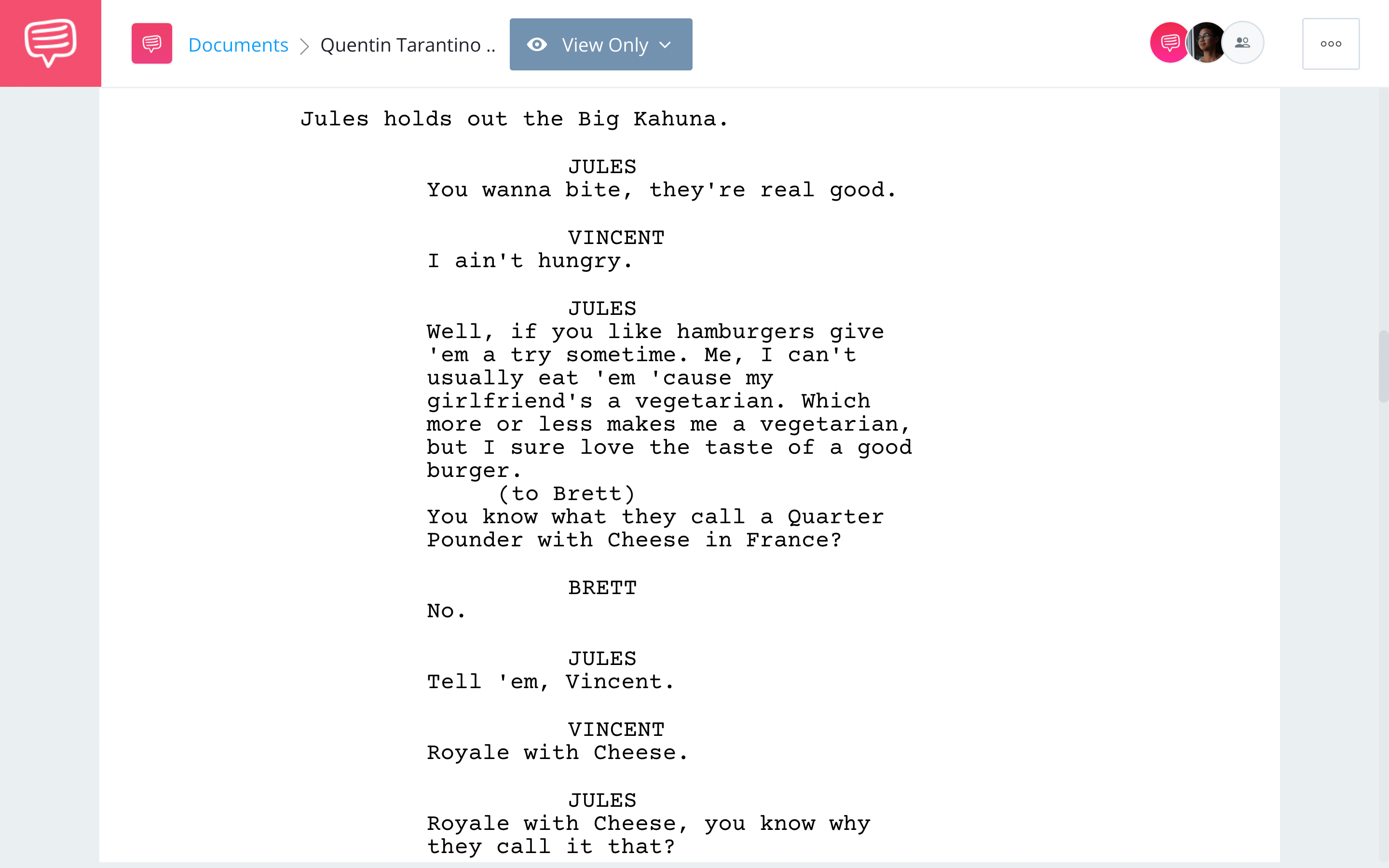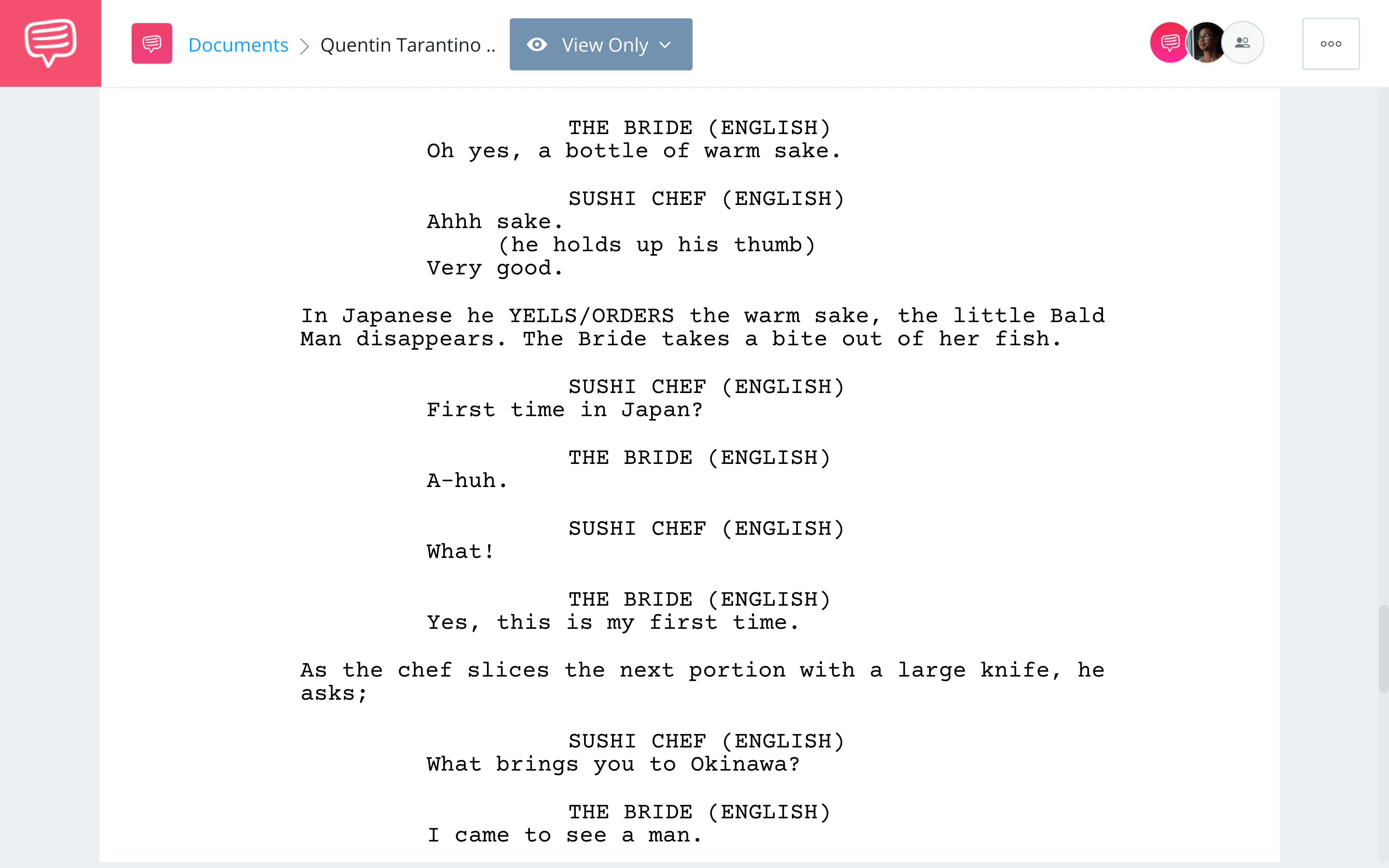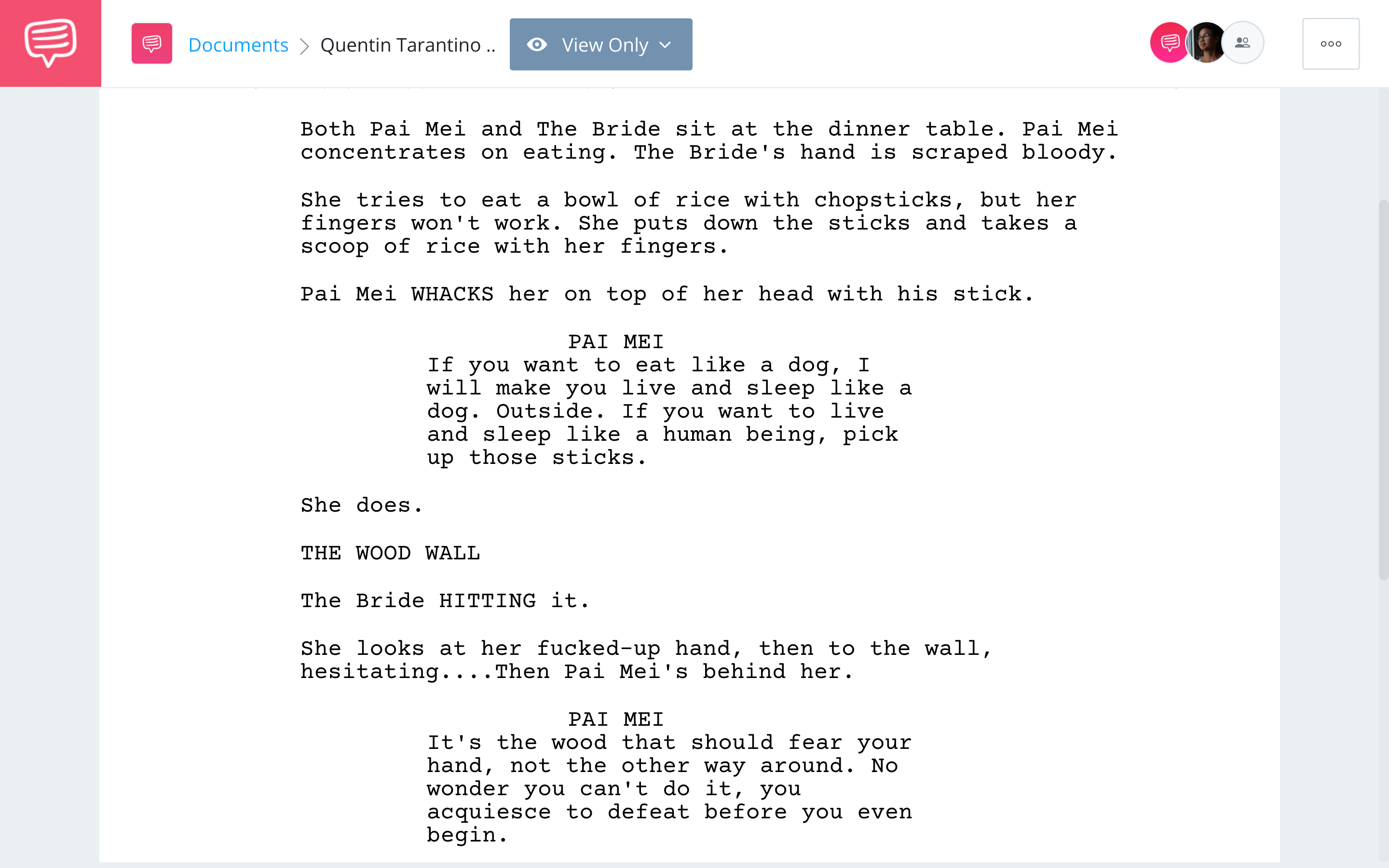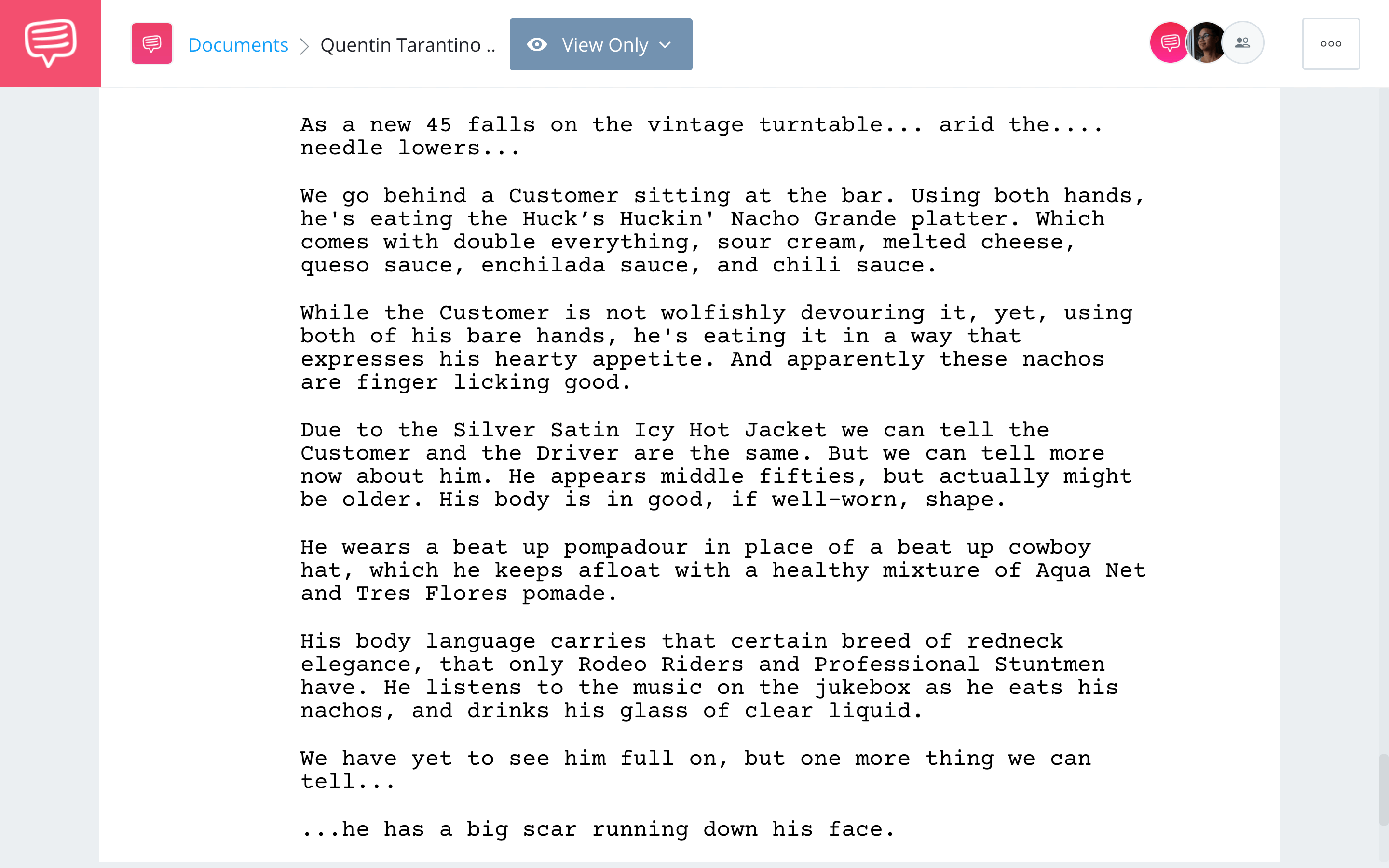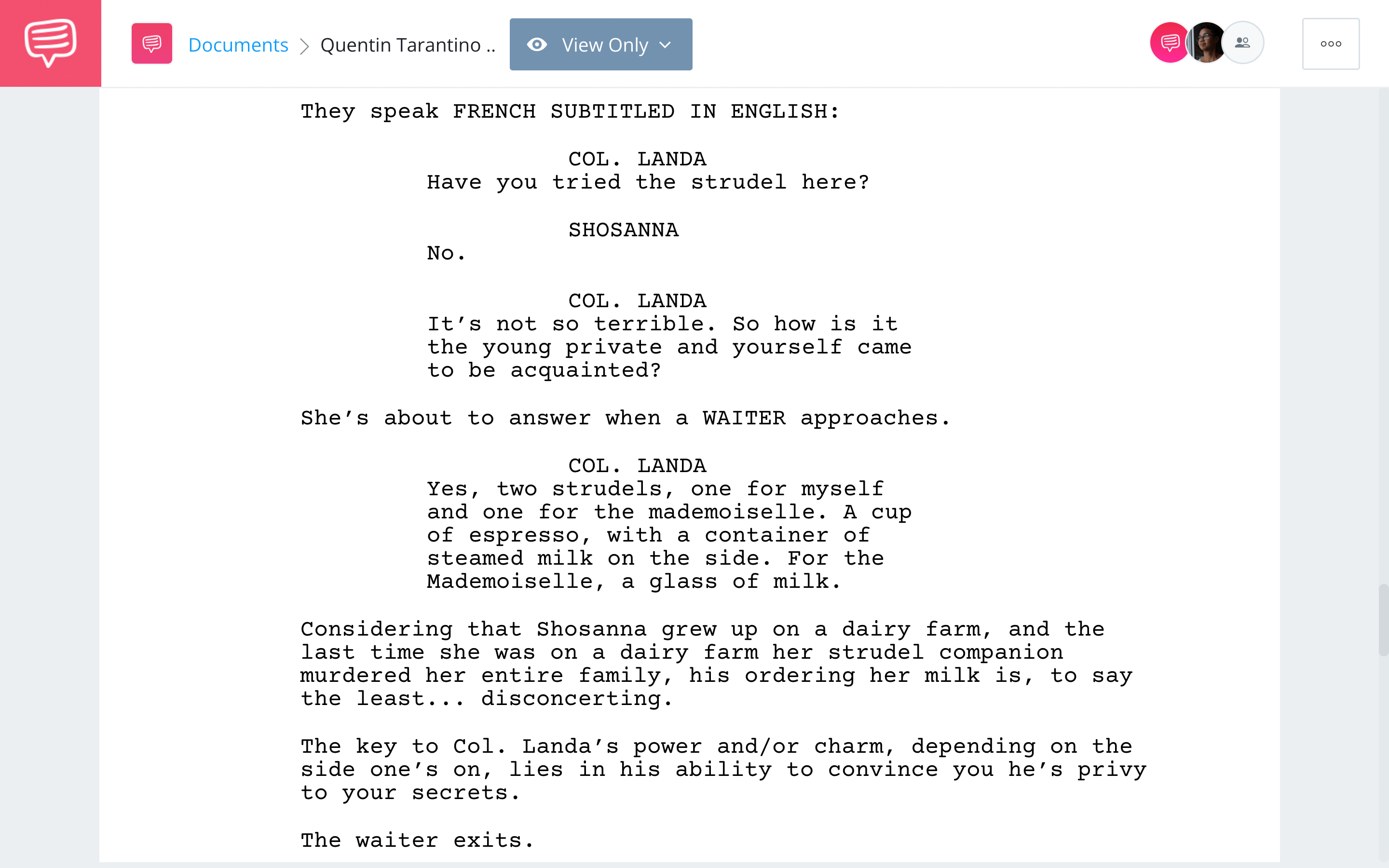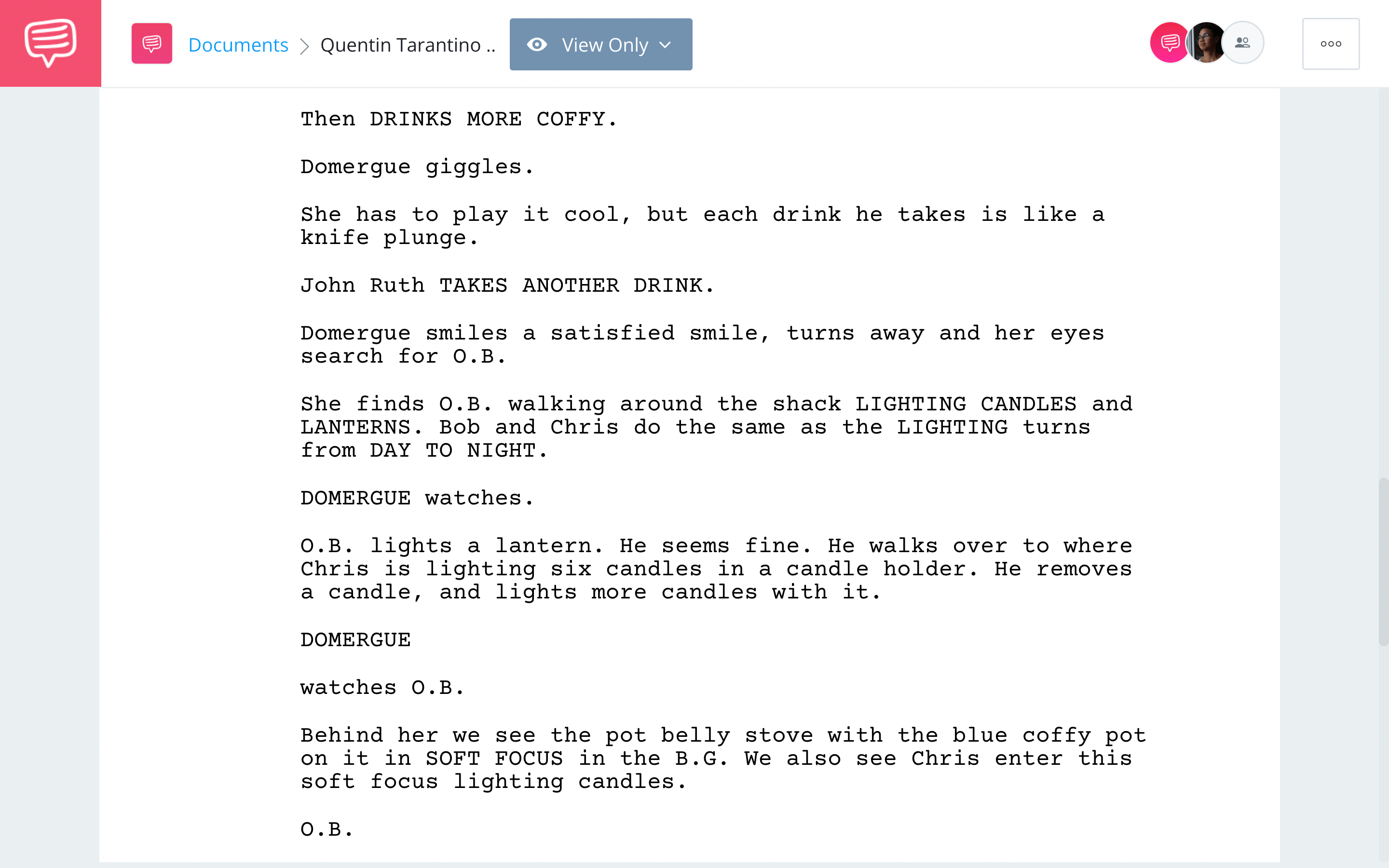Quentin Tarantino is known for a lot of things: distinct dialogue, explosive violence, pop culture pastiches. But his movies also contain another less-discussed element that is as important as his other signatures: food. In Tarantino movies, food is crucial. It can reveal character traits, propel plots, and expand themes. Some of Tarantino’s most famous scenes revolve around the consumption, or discussion, of food and drinks. In this post, we’ll give you a comprehensive list of all the food in every Tarantino film, along with analysis of some of the most significant examples.
Tarantino Food Menu — PDF Download
Click to view and download the entire Tarantino Food Menu PDF below.
Click above to download Tarantino Food Menu PDF
Food in Tarantino Movies
Reservoir Dogs
Reservoir Dogs may not have as extensive a menu as Quentin Tarantino’s later films, but this doesn’t mean food doesn’t play a big role. Take, for example, Mr. Orange and Holdaway getting late-night eats at a diner (a favorite location of Tarantino’s, as we’ll see).
It might not seem like the food here is a big deal, but in his script, Tarantino seems to indicate otherwise. We imported the script into StudioBinder's screenwriting software. Click the image below and take a look at his description at the beginning of the scene.
Quentin Tarantino food scenes • Read the Reservoir Dogs scene
Notice just how much space Tarantino gives to describing the food. We can see this as a prime example of how he uses food for characterization. This is our introduction to Holdaway, and Tarantino’s in-depth description of how he eats tells us intricacies about his character.
Eating in the middle of the night like this indicates Holdaway is probably not someone who works a conventional 9-to-5. Pouring out a whole bottle of ketchup tells us this isn’t a man who abides by moderation.
We can also see how the consumption of food allows Tarantino to pace his dialogue. This is a great example that proves Tarantino is thinking about how food will play a role in the scene, especially in terms of performance.
Tarantino food • Read the Reservoir Dogs scene
By noting when Holdaway eats and how, Tarantino is giving an actor suggestions on how to deliver their meaty monologues. It’s far more useful and informative than a simple “beat” or “he pauses.”
The food isn’t in the foreground of a scene, but Tarantino is paying close attention to the effect it’s having.
Additional Food/Drink:
- Coffee
- Whiskey
- Soda
- Pancakes and Sausage
- Strawberry Shake
Food in Tarantino Movies
True Romance
Even when Tarantino isn’t directing, his food-philia is ever-present. Tony Scott took the reins on this Tarantino screenplay, which is filled to the gills with a variety of meals.
One scene in which food is particularly important is the introduction to Gary Oldman’s Drexl, the pimp of Clarence’s lover, Alabama.
Here, the Chinese food Drexl is chomping down on works to color the dynamic between Clarence and the pimp.
Quentin Tarantino food scenes he didn't direct
At first, the food gives Drexl something else to focus on other than Clarence; it’s a way for him to show that the kid means nothing to him. Then, once he hears that Clarence is married to Alabama, his interest is piqued. He offers Clarence some of his food as a way to draw him into his web. Usually, this type of offer is a sign of friendship. Here, however, it’s a sign of domination.
Drexl also emphasizes just how much food he has, flexing the decadence in which he lives: “We got everything here from a diddle-eyed joe to a damned-if-I-know.”
When Clarence turns the food down, both characters clock this as a sign of aggression. Clarence won’t back down, and neither will the pimp. Drexl tries to corner Clarence by calling him a coward for not eating.
Take a look at his monologue.
Food in Tarantino movies • Read the True Romance scene
Food acts as a lens through which Drexl can insult Clarence’s character. Declining food is an act of weakness.
But Clarence flips Drexl’s rhetoric on its head. He reiterates his position, this time with an air of open hostility: “I'm not eatin' 'cause I'm not hungry. I'm not sittin' 'cause I'm not stayin.' I'm not lookin' at the movie 'cause I saw it seven years ago.”
Thus, in this True Romance scene, Tarantino uses food to deliver relational subtext. The characters are talking about the meal in front of them, but the meaning of conversation is much deeper.Additional Food/Drink:
- Beer
- Popcorn and Soda
- Chinese Takeout
- Champagne
- Hamburgers
- 7-Up
- Yoohoo
- Fritos
- Animal Crackers
- Coke
- Coffee
Pulp Fiction Milkshake
Pulp Fiction
As you can see, Tarantino’s most influential film is also one of the most food-heavy. Pulp Fiction has multiple scenes which revolve around food, many of them iconic. Take Jules and Vincent’s conversation on the way to a job. Their bickering about a "Royale with Cheese" has become one of the most quoted scenes in cinematic history.
Perhaps the most important use of food in the film, however, is Jules and the Big Kahuna burger.
The burger appears when Jules and Vincent enter the apartment of Brett, a business associate of their boss, from whom they’re supposed to retrieve a briefcase. Brett is in the middle of eating the Big Kahuna, and Jules takes note.
Big Kahuna Burger in Pulp Fiction
The beginning of their conversation revolves almost exclusively around the burger. It’s clear Brett is terrified, giving timid, monosyllabic answers as Jules nonchalantly interrogates him about his breakfast.
Then, Jules takes a bite out of the burger. It’s a sign of ultimate disrespect and domination – he can take whatever he wants, whenever he wants it. And the burger does more than just inform the power differential between Jules and Brett. Take a look at this exchange on the page.
Burger Pulp Fiction scene • Read the Pulp Fiction scene
In this exchange, Brett inadvertently oversteps his bounds. He guesses correctly as to why the Royale with Cheese has that name, and it clearly irks Jules, who gives a sarcastic reply. This back and forth tells us a bit more about Brett – he’s educated, perhaps a college kid who’s gotten in over his head.
To reassert his dominance, Jules drinks the rest of Brett’s Sprite. Samuel L. Jackson uses this action to really punctuate his character’s distaste for Brett– instead of a “sip,” as directed in the script, he takes a very, very long gulp.
The rest, of course, is movie history.
Additional Food/Drink:
- Coffee
- Royale with Cheese
- Big Kahuna Burger with Sprite
- Beer
- Whiskey on the Rocks
- Vanilla Shake
- Coke
- Cheeseburger and Fries
- Steak and Fries
- Fruit Brute Cereal
- Pancakes with Syrup
- Blueberry Pie with Cheese
- Bloody Mary
- Pop Tarts
- Bacon
- Muffin
Food in Tarantino Movies
From Dusk Till Dawn
Big Kahuna burgers return in From Dusk Till Dawn, a Tarantino script directed by Robert Rodriguez, but let’s look at a different form of sustenance: drink. In Dusk Till Dawn, liquor plays a similar role as the Big Kahuna burger does in Pulp Fiction. Take a look at this confrontational scene.
Tarantino Food and Drink in From Dusk Till Dawn
In this exchange, being denied a drink is a sign of aggression. Who gets to consume alcohol and who doesn’t tells us who has the power. When Razor drinks his whiskey, Seth feels slighted, saying, “Are you telling me that I’m not good enough to drink here?”
The act almost leads to a physical altercation until Jacob steps in and resolves the misunderstanding. Sure enough, by the end of the scene, Seth is enjoying a drink — he’s been accepted.
Additional Food/Drink:
- Coffee
- Big Kahuna Burgers
- Beer
- Whiskey Shots
Food in Tarantino Movies
Jackie Brown
Let’s stick with drinks for a moment. In Jackie Brown, Tarantino uses beverages to increase a level of intimacy between characters, rather than antipathy.
Jackie Brown’s coffee has a recurring role throughout the film, and in a scene between her and bail bondsman Max Cherry, the drink represents a deepening of their relationship.
"Want some coffee?"
Notice how differently the presence of coffee is handled in comparison to the whiskey in the last scene. Here, it’s a beverage to be shared, and, crucially, it isn’t being demanded. Instead, Max accepts the offer, but only if Jackie herself is having some.
We also get to see the easy-going nature of Max on full display. When Jackie laments that the milk has gone bad, Max is perfectly content with black coffee.
The making of coffee also gives the scene some dynamic blocking. While Max is trying to figure out this mystery woman, she is obscured by kitchen cabinets in the other room while she makes the beverage. When she reenters with the coffee, their conversation is less business-oriented, and more intimate.
Max and Jackie’s relationship is one of the warmest of Tarantino’s filmography, and it’s this scene over a cup of coffee that makes that possible.
Additional Food/Drink:
- Whiskey on the Rocks
- Coffee
- Evian Water
- Vodka on the Rocks
- White Wine
- Roscoe’s Chicken and Waffles
- Screwdriver
- Noodles
- Shake
- Teriyaki and Soda
- Steak and A1 Sauce
Food in Tarantino Movies
Kill Bill: Vol. 1
In Kill Bill: Vol. 1, Tarantino often uses food to establish setting. We can look at the Bride’s introduction to Hattori Hanzo as a prime example. Hanzo makes sushi for the Bride, and, in doing so, introduces the Bride and the audience, to the ways of Japanese cuisine.
Kill Bill Vol. 1 • Quentin Tarantino food scenes
The food in the scene also pushes the plot forward. By having Hanzo chef up some sushi, Tarantino is able to show off Hanzo’s coveted steel in the form of sushi knives.
Additionally, the meal builds trust. When the Bride orders Sake, she immediately gains Hanzo’s respect, an important step since she is about to hit him with a big ask.
Quentin Tarantino food scenes • Read Kill Bill Vol. 1 Food Scene
This scene’s delicacy provides a great juxtaposition with a meal provided in Volume 2. Let’s get to that next.
Additional Food/Drink:
- Coffee
- Cereal
- Sashimi
- Sake
- Sushi
Food in Tarantino Movies
Kill Bill: Vol. 2
In Kill Bill: Vol. 2, the Bride is pushed to her limits, and Tarantino emphasizes this with food. The climax of his over-the-top training montage between Pai Mei and the Bride boils down to a simple meal.
Throughout the montage, we see the Bride getting overworked in a variety of ways: punching thick wood, carrying massive jugs of water, getting hit with a cane. But it isn’t until she sits down to eat a bowl of rice when we see just how big of a toll the training has taken on her.
Food in Tarantino movies as a reward
First, the choice of food itself is telling. In comparison to the meal from Kill Bill: Vol. 1, this is barebones. The Bride is low on comforts and nourishment.
Second, the way she eats is a devastating portrayal of her physical state. Take a look at how it’s written on the page.
Pai Mei's Rice • Read Kill Bill Vol. 2 Food Scene
Interestingly, this is a rare example amongst Quentin Tarantino food scenes for not giving the food as much attention in his script as much as he does in his film. What Tarantino sums up as “she does” in his screenplay, his film spends nearly a minute (usually a page of a script) depicting.
It was a good call. By spending time showing just how difficult it is for the Bride to eat, we can see two things: 1) just how close she is to her breaking point and 2) the first note of sympathy in Pai Mei’s eyes.
Additional Food/Drink:
- Whiskey
- Peanuts
- Rice
- Margaritas
- Poisoned Fish Heads
- Ham and Cheese Without the Crust
Nacho Grande Platter Death Proof
Death Proof
Sometimes food in a Tarantino movie just looks good. Perhaps the most delicious-looking meal of all of Tarantino’s filmography appears in one of his least-seen films, Death Proof.
If you’ve seen the movie, you know what we’re talking about: those nachos.
Quentin Tarantino food scenes to the extreme
These chips look delectable, and the outrageous sound design emphasizes just how carnivorous Stuntman Mike is — a movement as simple as a nacho getting picked up off the plate sounds like a cow getting torn in half.
This is Stuntman Mike’s introduction, and it makes him look more animal than man. Take a look at the scene in Tarantino’s own words.
Nacho Grande platter Death Proof • Read Death Proof Food Scene
The man nearly gives us the recipe for the dish. It’s no wonder, then, that the nachos are so fully realized in the film, and, as a result, look so delicious.
Additional Food/Drink:
- Margaritas
- Nachos
- Wild Turkey
- Virgin Piña Colada
- Chartreuse
- Long Island Iced Tea
- Bombay Sapphire Gin & Tonic
Inglourious Basterds Strudel
Inglourious Basterds
Speaking of food which looks delicious — in Inglourious Basterds, Tarantino uses food similarly to Kill Bill: Vol. 1, spending time illuminating cultural heritage through a sacred dish.
The dish in question in Basterds is, of course, the strudel to end all strudels.
Inglourious Basterds Strudel
The strudel is a pastry most often associated with Germany and Austria, and so Landa ordering the dish in France shows his belief in German superiority over all else. He can’t even bring himself to say the French can do the pastry justice. All he can say is, “It’s not so terrible.”
Like so many other of Quentin Tarantino food scenes, the meal in the sequence is used to highlight a power dynamic. Landa orders for Shosanna, and even goes so far as to tell her when she can eat.
Perhaps most threatening of all, however, is what he orders as her drink. Take a look at how Tarantino describes it in the film’s screenplay.
Inglourious Basterds strudel • Read Inglorious Basterds Strudel Scene
Tarantino is explicit in what the milk represents to Shosanna: it is a reminder of the murder of her family, and a reminder that their murderer is sitting right before her.
Even though the scene itself is tense, Tarantino goes out of his way to make the strudel look delicious. As Tarantino puts it, “I do like the fact that when you see my movies, there might be one drink or one piece of food that the audience fixates on… I defy anyone to not want strudel when you see Inglourious Basterds. It’s not just Nazi guys eating it, it’s like ‘Man, that strudel looks good!’”
Additional Food/Drink:
- Milk
- Red Wine
- Sandwich
- Champagne
- Strudel
- Espresso
- Beer
- Whiskey
White Cake Django
Django Unchained
Django Unchained has a lot of overlap with Inglourious Basterds. Both films are revisionist histories in which their protagonists right historical wrongs via violent means. So it’s only fitting that one of Django’s best food scenes is similar to that of Inglourious Basterds.
Calvin’s white cake looks delicious, but it’s placed within a scene of high tension that’s set against the backdrop of a horrific act.
Like with the strudel in Basterds, the fine dining that Calvin is showing off indicates his high status and (perceived) power over his opponent. He eats it casually, without a care in the world.
The beauty of the cake, which Tarantino focuses on through a close-up, creates a cognitive dissonance in the audience: it’s a pretty thing in an ugly context.
The cake therefore feeds into a larger theme of Django Unchained. The lavish lifestyle of the South’s plantation owners is only made possible by some of the most horrific evils, just barely hidden under a gaudy veneer.
The farce of dignified elegance can be peeled away as easily as Dr. Schultz exposes Calvin’s ignorance about The Three Musketeers.
Additional Food/Drink:
- Beer
- Beans and Cornbread
- Champagne
- Collard Greens
- Biscuits
- Sweet Tea and Bourbon
- Red Wine
- Steak with Mashed Potatoes, Green Beans, and Gravy
- Polynesian Pearl Diver
- Jelly Beans
- White Cake
Minnie’s Haberdashery Stew
The Hateful Eight
In films like Kill Bill: Vol. 1 and Jackie Brown, Tarantino uses food and drink to build trust. In The Hateful Eight, he does the opposite. It’s fitting, because the film essentially revolves around a game of trust between strangers.
In this scene, it’s poisoned coffee which kicks off the spiral of distrust that infects the rest of the film.
The Hateful Eight • Poisoned Coffee & Minnie's Haberdashery Stew
It’s a scene which plays out like a classic Western standoff, except only one person in the room knows there’s a weapon involved.
Through his deliberate shot selection, Tarantino builds tense, shifting perspectives from eyeline to eyeline.
On the page, he pretty much lays out the exact coverage he wants.
Food in Tarantino movies • Read The Hateful Eight scene
A slow build and then a quick payoff — exactly like an old Western shootout. But by using coffee instead of guns, Tarantino is able to build the distrust that is so crucial to how the film operates.
Additional Food/Drink:
- Coffee
- Minnie’s Haberdashery Stew
- Poisoned Coffee
- Peppermint Stick
- Jelly Beans
Food in Tarantino Movies
Once Upon A Time… In Hollywood
Once Upon A Time… In Hollywood contains one of the most effective characterizations through food Tarantino has ever done, which, as we’ve established, is saying a lot.
When we are introduced to Cliff’s dog, Brandy, Cliff is still a bit of an enigma. But as we see Cliff prepare dinner for the both of them, we learn a lot more about him.
Food in Quentin Tarantino movies
First, we see that Cliff really loves this dog. He’s got an entire cabinet dedicated to the burly pooch’s food. And there’s a lot of food. Cliff makes an overflowing plate for his pet, and we see how well-trained his canine friend is as Brandy waits for Cliff to finish preparing his own meal.
Cliff’s dinner is one you might expect a hungry adolescent would make: a pot of mac ‘n’ cheese… eaten out of the pot. It’s a meal that represents Cliff’s lifestyle as a whole — this is someone in arrested development.
The two then both devour their respective suppers simultaneously. This intercutting encourages the audience to notice the similarities between the dog and the man. Both are loyal, and both are not to be messed with.
Without giving anything away, these similarities are crucial to the film’s climax, and they’ve all been established with barely a word. In Tarantino’s dialogue-heavy films, food often speaks for itself.
Additional Food/Drink:
- Bloody Mary
- Whiskey on the Rocks
- Dog Food (Wet and Dry)
- Mac ‘n’ Cheese
- Beer
- Whiskey Sour
- French Press Coffee
- BLT
- Chili
- Frozen Margaritas
Up Next
Tarantino’s Favorite Movies Ever
Quentin Tarantino didn’t create his distinct style in a vacuum. Perhaps more than almost any other filmmaker, Tarantino fills his movies with references to other films. Take a look at a list of films that he has said have influenced him.
Up Next: Tarantino's Favorites →
Share your vision with elegant shot lists and storyboards.
Create robust and customizable shot lists. Upload images to make storyboards and slideshows.

